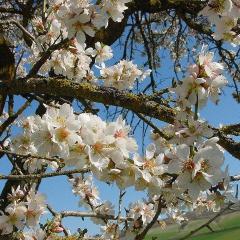
Environmental Justice Rooted in Tu Bi-Sh’vat
Trees are the skyscrapers of the plant world. Their majesty inspires us, and their bounty provides us with food, shelter, and fuel. And of course, as any preschooler will tell you, we need trees for the very air we breathe. By caring for trees we care for our world too. How wonderful it is then, that we celebrate the birthday of the trees every year on Tu Bi-Sh’vat, the 15th day of the Jewish month of Sh’vat, the New Year for Trees!
Trees have long held a place of honor in Judaism. Our precious Torah is called Eitz Chayim, Tree of Life. Just as a tree gives our bodies nourishment, our Torah gives us nourishment for the soul. We make this connection in our liturgy at every Torah service. You can hear a particularly beautiful setting of Eitz Chayim composed by ACC member, Cantor Robbie Solomon, performed by cantorial students at the Debbie Friedman School of Sacred Music of Hebrew Union College at this link: Eitz Chayim Hi
Initially, Tu Bi-Sh’vat marked the beginning of the tax year. The Torah instructs us to wait before harvesting a tree’s fruit. The holiday also provided a framework for farmers who needed a system for calculating a year’s yield for tithing to the priests.
When you enter the land and plant any tree for food, you shall regard its fruit as forbidden. Three years it shall be forbidden for you, not to be eaten. In the fourth year all its fruit shall be set aside for jubilation before the Lord; and only in the fifth year may you use its fruit – that its yield to you may be increased: I the Lord am your God. (Leviticus 19:23-25)
The opening of this biblical text, Ki Tavo’u,(also called B’rachah L’Tu Bi-Sh’vat) is often sung to an evocative Yemenite folk melody. You can hear an exciting, rhythmic performance of this tune by Iris and Ofer Portugaly with their gospel choir here: Ki Tavo’u
Later, the mystics of Safed celebrated Tu Bi-Sh’vat as one of the four New Years indicated in the Mishnah. Using the Passover Haggadah as a model, they created a seder, P’ri Etz Hadar (Fruit of the Goodly Tree), first published in 1753, in which fruit and wine were consumed in a specific order. According to the Kabbalists, partaking of the fifteen different types of fruit and four colors of wine, each with specific attributes, and then reciting the appropriate blessings would help bring tikkun olam, repair of the world. P’ri Etz Hadar was first accepted by the Sephardic community, and only later by Ashkenazim. The Sephardic community celebrates Tu Bi-Sh’vat, also known as Las Frutas (Feast of Fruits), Fruticas or Frutikas, with special traditions and music. The following excerpt, entitled “Hamisha Asar,” is by Flory Jagoda and sung by the Madison youth choirs: Hamisha Asar
In the early years of the Zionist movement, Tu Bi-Sh’vat became a rallying point for reclamation of the land, and trees were planted to commemorate the occasion. In 1890, Rabbi Ze’ev Yavetz took his students to plant saplings in Zichron Yaakov on Tu Bi-Sh’vat, and within twenty years the Jewish Teachers Union in Israel adopted this practice. Established in 1901, the Jewish National Fund’s mission was to buy tracts of land in Palestine for the Jewish people, later becoming known for planting trees and afforestation.
More recently, Tu Bi-Sh’vat has become a way for Jews across the globe to connect with the land of Israel. When much of North America is blanketed with snow, we know that in Eretz Yisrael new life is flowing, as the sap of fruit trees begins to run, and soon the almond tree will send out its blossoms.
We also are reminded of our duties to steward the land wisely, and not wantonly to destroy or waste our resources.
When in your war against a city you have to besiege it a long time in order to capture it, you must not destroy its trees, wielding the ax against them. You may eat of them, but you must not cut them down. Are trees of the field human to withdraw before you into the besieged city? (Deuteronomy 20:19)
From this text comes the idea of Bal Tashchit, which is Aramaic for “do not waste.” If we are not to cut down fruit trees during times of war, how much the more so should we protect them during times of peace! The rabbis expanded this concept to all careless destruction (Kiddushin 32a).
Likewise, the prophet Isaiah admonishes us not to hurt or destroy (Isaiah 11:9). Furthermore, we should re-tool our “swords into plowshares” and our “spears into pruning hooks” (Isaiah 2:4). Very clearly, we are commanded to care for our world, make peace, and feed our communities. You can hear a NFTY recording of “Lo Yarei’u/V’chit’tu” from Isaiah by Cantor William Sharlin and Ezri Gabbai at this link: Lo Yarei’u/V’chit’tu
Again and again in Judaism, we are reminded of the importance of trees, and by extrapolation, our natural world given to us by God. We are told to tend to the earth and our future, teaching these values diligently to our children. The earth is our garden, and as Todd Herzog says in his song, we must “Tend our Garden.” Tend Our Garden
Environmental justice is rooted in biblical text. Tu Bi-Sh’vat, the New Year for Trees, once an annual marker for tithing, now reminds us to take account of our responsibility to the earth, and how our choices affect all living creatures on this one irreplaceable world.

